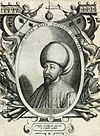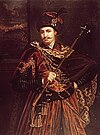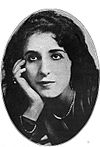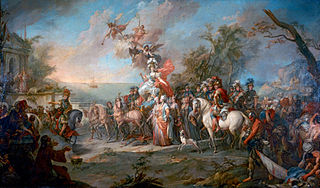
The Russo-Turkish War of 1768–1774 was a major armed conflict that saw Russian arms largely victorious against the Ottoman Empire. Russia's victory brought the Yedisan between the rivers Bug and Dnieper, and Crimea into the Russian sphere of influence. Through a series of victories accrued by the Russian Empire led to substantial territorial conquests, including direct conquest over much of the Pontic–Caspian steppe, less Ottoman territory was directly annexed than might otherwise be expected due to a complex struggle within the European diplomatic system to maintain a balance of power that was acceptable to other European states and avoided direct Russian hegemony over Eastern Europe.

The Ottoman Empire was founded c. 1299 by Osman I as a small beylik in northwestern Asia Minor just south of the Byzantine capital Constantinople. In 1326, the Ottomans captured nearby Bursa, cutting off Asia Minor from Byzantine control. The Ottomans first crossed into Europe in 1352, establishing a permanent settlement at Çimpe Castle on the Dardanelles in 1354 and moving their capital to Edirne (Adrianople) in 1369. At the same time, the numerous small Turkic states in Asia Minor were assimilated into the budding Ottoman sultanate through conquest or declarations of allegiance.

Wilhelm Leopold Colmar Freiherr von der Goltz, also known as Goltz Pasha, was a Prussian field marshal and military writer.
In diplomatic history, the Eastern question was the issue of the political and economic instability in the Ottoman Empire from the late 18th to early 20th centuries and the subsequent strategic competition and political considerations of the European great powers in light of this. Characterized as the "sick man of Europe", the relative weakening of the empire's military strength in the second half of the eighteenth century threatened to undermine the fragile balance of power system largely shaped by the Concert of Europe. The Eastern question encompassed myriad interrelated elements: Ottoman military defeats, Ottoman institutional insolvency, the ongoing Ottoman political and economic modernization programme, the rise of ethno-religious nationalism in its provinces, and Great Power rivalries. In an attempt to triangulate between these various concerns, the historian Leslie Rogne Schumacher has proposed the following definition of the Eastern Question:
The "Eastern Question" refers to the events and the complex set of dynamics related to Europe's experience of and stake in the decline in political, military and economic power and regional significance of the Ottoman Empire from the latter half of the eighteenth century to the formation of modern Turkey in 1923.
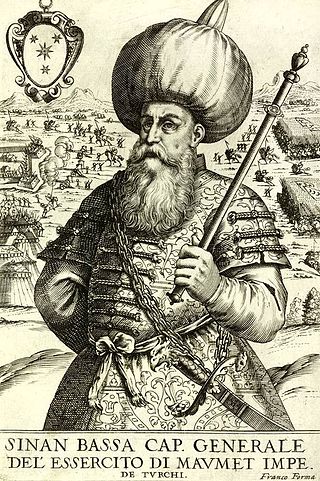
Koca Sinan Pasha was an Albanian-born Ottoman Grand Vizier, military figure, and statesman. From 1580 until his death he served five times as Grand Vizier.

The Great Turkish War, also called the Wars of the Holy League, was a series of conflicts between the Ottoman Empire and the Holy League consisting of the Holy Roman Empire, Poland-Lithuania, Venice, Russia, and the Kingdom of Hungary. Intensive fighting began in 1683 and ended with the signing of the Treaty of Karlowitz in 1699. The war was a defeat for the Ottoman Empire, which for the first time lost substantial territory, in Hungary and the Polish–Lithuanian Commonwealth, as well as in part of the western Balkans. The war was significant also for being the first instance of Russia joining an alliance with Western Europe.

Russo-Turkish wars or Russo-Ottoman wars were a series of twelve wars fought between the Russian Empire and the Ottoman Empire between the 16th and 20th centuries. It was one of the longest series of military conflicts in European history. Except for the war of 1710–11, as well as the Crimean War which is often treated as a separate event, the conflicts ended disastrously for the Ottoman Empire, which was undergoing a long period of stagnation and decline; conversely, they showcased the ascendancy of Russia as a European power after the modernization efforts of Peter the Great in the early 18th century.
Gedik Ahmed Pasha was an Ottoman statesman and admiral who served as Grand Vizier and Kapudan Pasha during the reigns of sultans Mehmed II and Bayezid II.
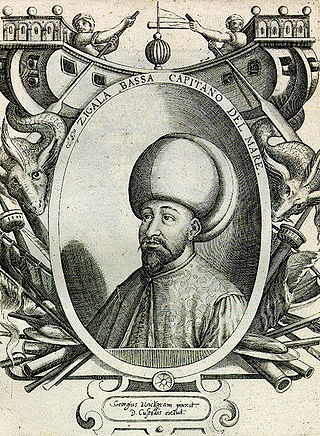
Cığalazade Yusuf Sinan Pasha, his epithet meaning "son of Cicala", was an Ottoman Italian statesman who held the office of Grand Vizier for forty days between 27 October to 5 December 1596, during the reign of Mehmed III. He was also a Kapudan Pasha as well as a military general. He was one of the most capable statesmen of the Ottoman Classical Age, having contributed to the eastwards expansion of the empire at the expense of Persia and successfully defended Ottoman Hungary from Habsburg invasion. However, because of court intricacies, he resigned from the Vizierate after just over a month in office.
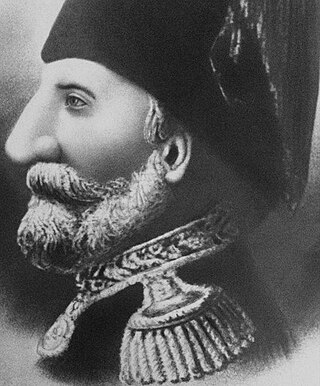
Koca Hüsrev Mehmed Pasha was an Ottoman admiral, reformer and statesman, who was Kapudan Pasha of the Ottoman Navy. He reached the position of Grand Vizier rather late in his career, between 2 July 1839 and 8 June 1840 during the reign of Abdulmejid I. However, during the 1820s, he occupied key administrative roles in the fight against regional warlords, the reformation of the army, and the reformation of Turkish attire. He was one of the main statesmen who predicted a war with the Russian Empire, which would eventually be the case with the outbreak of the Crimean War.

The Ottoman Navy or The Imperial Navy, also known as the Ottoman Fleet, was the naval warfare arm of the Ottoman Empire. It was established after the Ottomans first reached the sea in 1323 by capturing Praenetos, the site of the first Ottoman naval shipyard and the nucleus of the future navy.
Iliaș Colceag was a Moldavian mercenary and military commander in the Ottoman and Russian Empire.
The territorial evolution of the Ottoman Empire spans seven centuries.

The following outline is provided as an overview of and topical guide to the Ottoman Empire:
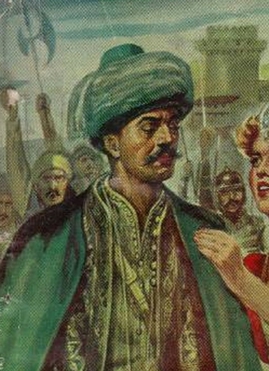
Gazi Hüseyin Pasha, also known as Deli Hüseyin Pasha or Sarı Hüseyin Pasha or Baltaoğlu Hüseyin Pasha, was an Ottoman military officer and statesman. He was governor of Egypt (1635–1637), Kapudan Pasha in the 1630s, and briefly Grand Vizier in 1656.
Kara Murat Pasha, or Kara Dev Murad Pasha, lit. Courageous Giant Murat Pasha in Ottoman Turkish;, was an Ottoman Albanian statesman and military officer. He served as Kapudan Pasha and twice as Grand Vizier. His epithet Kara ("black") refers to his courage and Dev ("giant") to his physical size.

Ottoman Tunisia, also known as the Regency of Tunis, refers to the Ottoman presence in Ifriqiya from the 16th to 19th centuries, when Tunis was officially integrated into the Ottoman Empire as the Eyalet of Tunis. The Ottoman presence in the Maghreb began with the takeover of Algiers in 1516 by the Ottoman Turkish corsair and beylerbey Aruj, eventually expanding across the entire region except for Morocco. The first Ottoman conquest of Tunis occurred in 1534 under the command of Khayr al-Din Barbarossa, the younger brother of Aruj, who was the Kapudan Pasha of the Ottoman Fleet during the reign of Suleiman the Magnificent. However, it was not until the final Ottoman reconquest of Tunis from Spain in 1574 that the Turks permanently acquired the former territories of Hafsid Tunisia, retaining it until the French occupation of Tunisia in 1881.

The Ottoman Army was the army of the Ottoman Empire after the country was reorganized along modern western European lines during the Tanzimat modernization period. It operated during the decline and dissolution of the empire, which roughly occurred between 1861 and 1918, the end of World War I for the Ottomans. The Crimean War was the first war effort in which the modern army took part in, proving itself as a decent force. The last reorganization occurred during the Second Constitutional Era.
The Ministry of War was responsible for war affairs in the Ottoman Empire. The Ottoman land forces were subordinate to this ministry. Within the ministry there were offices for procurement, combat arms, peacetime military affairs, mobilization, and for promotions.
David Passi, also known as Halil Pasha, was a Marrano who was Sultan Murad III's favourite, spy, adviser, and confidant. Despite this, Passi was not loyal to any one monarch since he worked as an agent for the Ottoman Empire, England, Venice, and Spain, all at the same time. He later chose to only serve the Ottomans. It was because of the ease of how Jews travelled throughout the Ottoman Empire was Passi and many other Jewish double agents able to remain uncaught for a long time, sometimes never.







